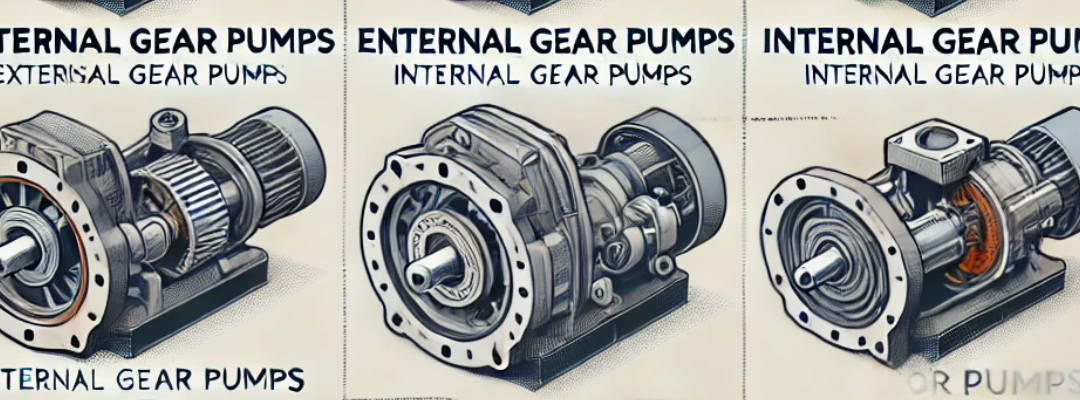Choosing the right gear pump is essential for ensuring efficiency and durability in industrial applications. Each type of gear pump comes with distinct advantages and is best suited for specific conditions. Understanding their mechanisms, applications, and limitations can help you make informed decisions when selecting a pump for your needs.
A well-matched pump should handle the viscosity and particulate content of the liquid effectively. Poor selection can lead to clogs, wear, and increased maintenance costs. Below, we explore the five primary types of gear pumps, their working principles, and their common applications.
Screw-Type Gear Pump
Working Principle:
As the name suggests, screw-type gear pumps replace traditional gears with helical screw rotors to enhance fluid flow. The pump consists of one or multiple intermeshing screws that rotate within the housing. The inlet is divided into sections, guiding the liquid towards the screw, where it is gradually compressed and transported to the discharge port.
These pumps are ideal for applications requiring smooth, pulsation-free flow and excellent handling of viscous liquids.
Common Applications:
- Fuel injection systems – Ensures precise fuel delivery in engines.
- Lubrication systems – Used in industrial machinery and automotive lubrication.
- Hydraulics – Provides pressurized fluid for mechanical systems.
Lobe-Type Gear Pump
Working Principle:
Lobe pumps function similarly to external gear pumps, but instead of traditional gears, they use rotary lobes or pistons. These lobes rotate without coming into direct contact, creating gentle fluid transfer with minimal shear. This makes them ideal for handling delicate and high-viscosity fluids.
Additionally, lobe-type gear pumps offer high sanitation levels, making them popular in industries requiring strict hygiene standards.
Common Applications:
- Polymers – Used for moving high-viscosity polymer liquids.
- Paper coating – Ensures smooth application of coatings.
- Soaps, detergents & cosmetics – Gentle handling prevents foaming and degradation.
- Rubber & adhesives – Transfers viscous adhesives without contamination.
GE Rotor-Type Gear Pump
Working Principle:
This pump type employs dual rotating rotors that create suction and transport fluid in a continuous, non-pulsating flow. The smaller rotor has external teeth, while the larger rotor features internal teeth. As these gears engage, they drive the liquid forward with high efficiency and minimal turbulence.
GE rotor gear pumps are widely used for moderate to high-viscosity liquids, offering precision in flow control.
Common Applications:
- Light fuel oils – Used in industrial heating and power generation.
- Lubrication systems – Ensures smooth operation of rotating equipment.
- Hydraulic fluid circulation – Critical in industrial and automotive hydraulic systems.
Internal Gear-Type Gear Pump
Working Principle:
Internal gear pumps feature two interlocking gears, with a larger external gear encasing a smaller internal gear. A crescent-shaped divider fills the space between the gears, helping trap and direct the liquid. The design results in high efficiency, self-priming capabilities, and the ability to handle a wide range of fluids.
This pump type is particularly suited for viscous and temperature-sensitive fluids.
Common Applications:
- Asphalt & tar processing – Handles high-viscosity materials with ease.
- Resins & polymers – Ideal for chemical processing industries.
- Alcohols & solvents – Works efficiently with low and medium-viscosity solvents.
External Gear-Type Gear Pump
Working Principle:
External gear pumps feature two equally sized gears that rotate in opposite directions inside a tightly sealed housing. Unlike internal gear pumps, both gears mesh externally, which provides precise fluid transfer and high pressure output. One gear is typically motor-driven, while the second is driven by the meshing action.
This design makes external gear pumps ideal for transferring low to medium-viscosity fluids at high pressures.
Common Applications:
- Water & light oils – Efficient for general-purpose fluid movement.
- Chemical additives – Used in industrial chemical dosing.
- Hydraulic power units – Supports hydraulic machinery with controlled flow.
Choosing the Right Gear Pump for Your Application
Selecting the best gear pump requires evaluating fluid properties, pressure requirements, and operating conditions. Here’s a quick comparison table to guide your selection:
| Gear Pump Type | Best for High Viscosity? | High Pressure Applications? | Pulsation-Free Flow? | Self-Priming? |
| Screw-Type | ✅ Yes | ❌ No | ✅ Yes | ✅ Yes |
| Lobe-Type | ✅ Yes | ❌ No | ✅ Yes | ✅ Yes |
| GE Rotor-Type | ✅ Yes | ✅ Yes | ✅ Yes | ✅ Yes |
| Internal Gear | ✅ Yes | ✅ Yes | ✅ Yes | ✅ Yes |
| External Gear | ❌ No | ✅ Yes | ❌ No | ❌ No |

